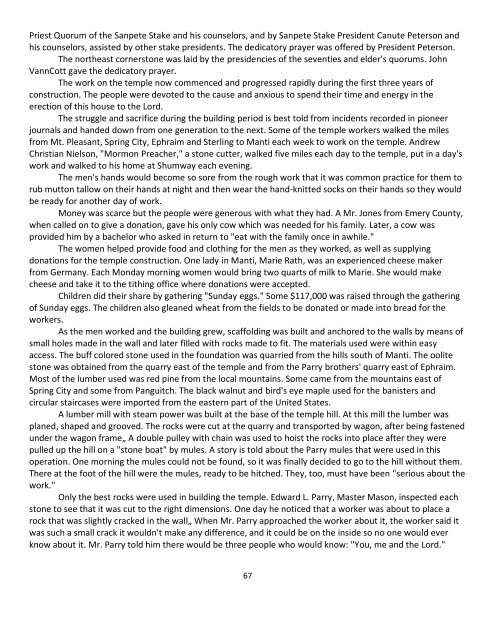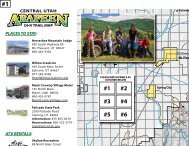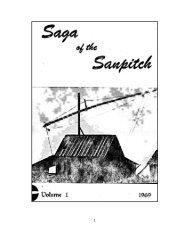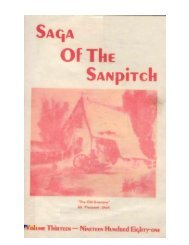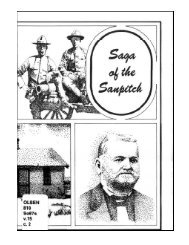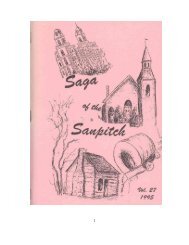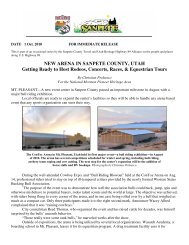Saga of the Sanpitch Volume 17, 1985 - Sanpete County
Saga of the Sanpitch Volume 17, 1985 - Sanpete County
Saga of the Sanpitch Volume 17, 1985 - Sanpete County
You also want an ePaper? Increase the reach of your titles
YUMPU automatically turns print PDFs into web optimized ePapers that Google loves.
Priest Quorum <strong>of</strong> <strong>the</strong> <strong>Sanpete</strong> Stake and his counselors, and by <strong>Sanpete</strong> Stake President Canute Peterson and<br />
his counselors, assisted by o<strong>the</strong>r stake presidents. The dedicatory prayer was <strong>of</strong>fered by President Peterson.<br />
The nor<strong>the</strong>ast cornerstone was laid by <strong>the</strong> presidencies <strong>of</strong> <strong>the</strong> seventies and elder's quorums. John<br />
VannCott gave <strong>the</strong> dedicatory prayer.<br />
The work on <strong>the</strong> temple now commenced and progressed rapidly during <strong>the</strong> first three years <strong>of</strong><br />
construction. The people were devoted to <strong>the</strong> cause and anxious to spend <strong>the</strong>ir time and energy in <strong>the</strong><br />
erection <strong>of</strong> this house to <strong>the</strong> Lord.<br />
The struggle and sacrifice during <strong>the</strong> building period is best told from incidents recorded in pioneer<br />
journals and handed down from one generation to <strong>the</strong> next. Some <strong>of</strong> <strong>the</strong> temple workers walked <strong>the</strong> miles<br />
from Mt. Pleasant, Spring City, Ephraim and Sterling to Manti each week to work on <strong>the</strong> temple. Andrew<br />
Christian Nielson, "Mormon Preacher," a stone cutter, walked five miles each day to <strong>the</strong> temple, put in a day's<br />
work and walked to his home at Shumway each evening.<br />
The men's hands would become so sore from <strong>the</strong> rough work that it was common practice for <strong>the</strong>m to<br />
rub mutton tallow on <strong>the</strong>ir hands at night and <strong>the</strong>n wear <strong>the</strong> hand-knitted socks on <strong>the</strong>ir hands so <strong>the</strong>y would<br />
be ready for ano<strong>the</strong>r day <strong>of</strong> work.<br />
Money was scarce but <strong>the</strong> people were generous with what <strong>the</strong>y had. A Mr. Jones from Emery <strong>County</strong>,<br />
when called on to give a donation, gave his only cow which was needed for his family. Later, a cow was<br />
provided him by a bachelor who asked in return to "eat with <strong>the</strong> family once in awhile."<br />
The women helped provide food and clothing for <strong>the</strong> men as <strong>the</strong>y worked, as well as supplying<br />
donations for <strong>the</strong> temple construction. One lady in Manti, Marie Rath, was an experienced cheese maker<br />
from Germany. Each Monday morning women would bring two quarts <strong>of</strong> milk to Marie. She would make<br />
cheese and take it to <strong>the</strong> tithing <strong>of</strong>fice where donations were accepted.<br />
Children did <strong>the</strong>ir share by ga<strong>the</strong>ring "Sunday eggs." Some $1<strong>17</strong>,000 was raised through <strong>the</strong> ga<strong>the</strong>ring<br />
<strong>of</strong> Sunday eggs. The children also gleaned wheat from <strong>the</strong> fields to be donated or made into bread for <strong>the</strong><br />
workers.<br />
As <strong>the</strong> men worked and <strong>the</strong> building grew, scaffolding was built and anchored to <strong>the</strong> walls by means <strong>of</strong><br />
small holes made in <strong>the</strong> wall and later filled with rocks made to fit. The materials used were within easy<br />
access. The buff colored stone used in <strong>the</strong> foundation was quarried from <strong>the</strong> hills south <strong>of</strong> Manti. The oolite<br />
stone was obtained from <strong>the</strong> quarry east <strong>of</strong> <strong>the</strong> temple and from <strong>the</strong> Parry bro<strong>the</strong>rs' quarry east <strong>of</strong> Ephraim.<br />
Most <strong>of</strong> <strong>the</strong> lumber used was red pine from <strong>the</strong> local mountains. Some came from <strong>the</strong> mountains east <strong>of</strong><br />
Spring City and some from Panguitch. The black walnut and bird's eye maple used for <strong>the</strong> banisters and<br />
circular staircases were imported from <strong>the</strong> eastern part <strong>of</strong> <strong>the</strong> United States.<br />
A lumber mill with steam power was built at <strong>the</strong> base <strong>of</strong> <strong>the</strong> temple hill. At this mill <strong>the</strong> lumber was<br />
planed, shaped and grooved. The rocks were cut at <strong>the</strong> quarry and transported by wagon, after being fastened<br />
under <strong>the</strong> wagon frame„ A double pulley with chain was used to hoist <strong>the</strong> rocks into place after <strong>the</strong>y were<br />
pulled up <strong>the</strong> hill on a "stone boat" by mules. A story is told about <strong>the</strong> Parry mules that were used in this<br />
operation. One morning <strong>the</strong> mules could not be found, so it was finally decided to go to <strong>the</strong> hill without <strong>the</strong>m.<br />
There at <strong>the</strong> foot <strong>of</strong> <strong>the</strong> hill were <strong>the</strong> mules, ready to be hitched. They, too, must have been "serious about <strong>the</strong><br />
work."<br />
Only <strong>the</strong> best rocks were used in building <strong>the</strong> temple. Edward L. Parry, Master Mason, inspected each<br />
stone to see that it was cut to <strong>the</strong> right dimensions. One day he noticed that a worker was about to place a<br />
rock that was slightly cracked in <strong>the</strong> wall„ When Mr. Parry approached <strong>the</strong> worker about it, <strong>the</strong> worker said it<br />
was such a small crack it wouldn't make any difference, and it could be on <strong>the</strong> inside so no one would ever<br />
know about it. Mr. Parry told him <strong>the</strong>re would be three people who would know: "You, me and <strong>the</strong> Lord."<br />
67


